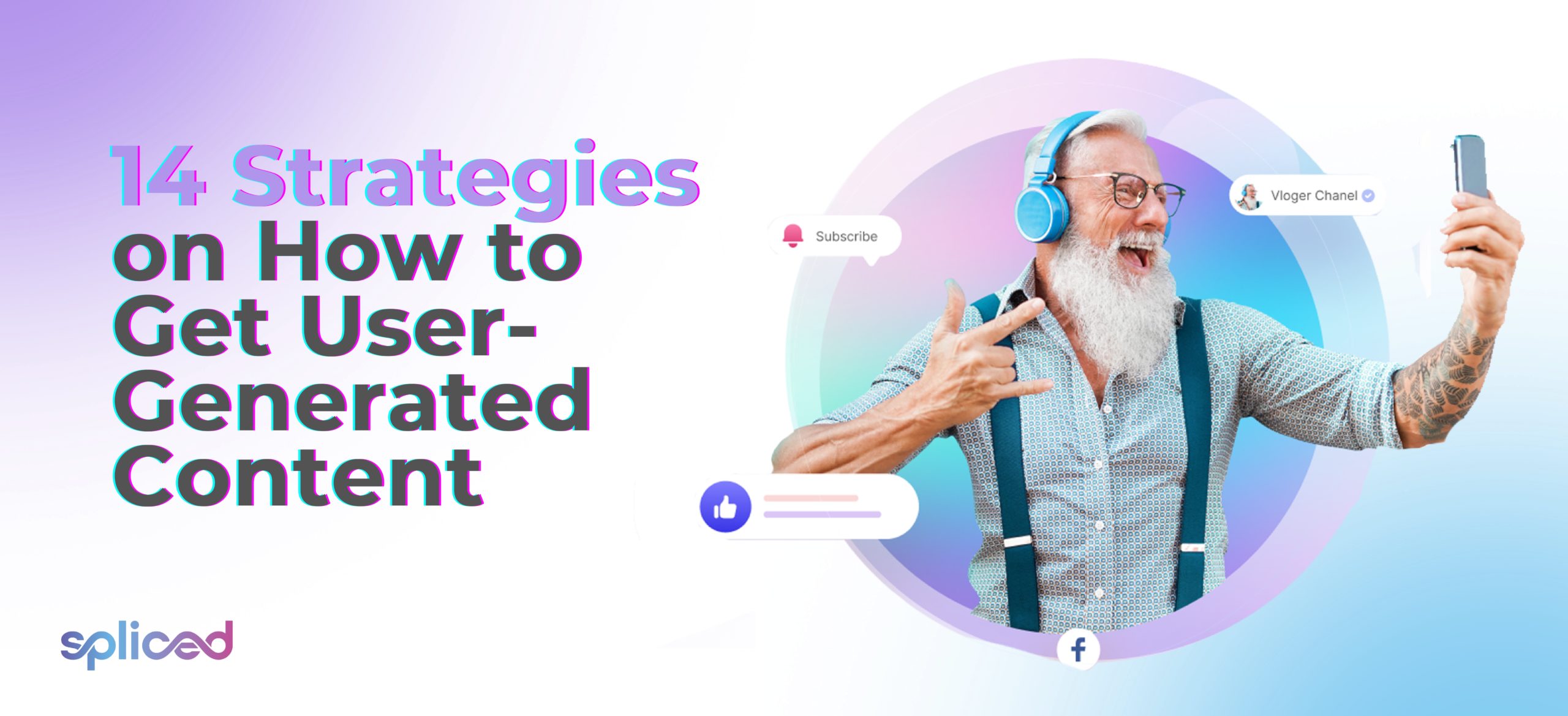The 14 strategies on how to get user-generated content remain essential in today’s digital landscape, and more tactics are used to attract and collect meaningful contributions from the audience. The 14 strategies involve encouraging users to share their experiences, stories, images, or videos relevant to the products or services. Running campaigns with specific themes or prompts is one effective user-generated content strategy. Using branded hashtags and promoting them in marketing materials helps users find and submit UGC. Customers are encouraged to engage and share content through contests, freebies, and incentives, such as awards or discounts.
Collaboration with influencers and engagement with the audience on social media platforms boost UGC. Constantly seeking client reviews and feedback via email marketing results in tons of user ideas. It effectively encourages consumers to contribute UGC content by building an impression of community around the organization, offering precise guidelines, and maintaining transparency and constant interaction. It improves the brand’s online presence and customer engagement. The strategies work together to build an engaging and dynamic relationship with the target audience, transforming them into active contributors and brand evangelists.
The strategies on how to get user-generated content are listed below.
- Recognize Trends Among Consumers: Recognizing consumer trends in User Generated Content (UGC) is an important component of knowing and exploiting their voice. UGC typically offers more genuine and recent insights into consumer behavior, preferences, and developing trends, compared to traditional market research.
- Use a Selfless Hashtag Strategy: Make branded hashtags for consumers to use while sharing material on social media. Promote and encourage the use of hashtags in marketing materials.
- Include Signs in Your Stores: Physical signage in businesses is utilized as part of a UGC strategy to encourage customers to share their in-store experiences.
- Organize an Event: Create UGC events or giveaways with appealing prizes. Require people to submit an entry into the contest with UGC, which increases participation.
- Examine Fan Photos that Already Exist: Using existing follower images on social media helps businesses capture User Generated Content (UGC) without actively seeking fresh content.
- Involve Influencers: Collaborate with specialized influencers to generate a UGC that is appealing to the followers and target audience.
- Encourage Clear CTAs In Important Spots: Clear “Calls-to-Action” (CTAs) are essential in User Generated Content (UGC) initiatives for promoting user engagement. CTAs lead users to specific activities, such as sharing, liking, commenting, or creating UGC by using enticing language and imagery.
- Present UGC as Social Currency: User Generated Content (UGC) is a social currency technique that creates a sense of community among users by utilizing digital recognition and belonging. It is used by brands to validate their content and encourage additional users to share their own stuff.
- Showcase Customers’ Pictures on Your Website: Create specialized UGC campaigns based on certain themes or prompts. Encourage individuals to submit their product or service-related experiences, tales, images, or videos to the company’s websites.
- Listen to the Users’ Social Conversations: Engage with the audience on social media and answer their posts, questions, and comments. Thank them for their UGC contributions.
- Establish a Program for Employee Engagement: Employee participation in User Generated Content (UGC) plans increases internal morale and external brand visibility by encouraging employees to contribute original content about a company, its products, or its principles.
- Set up An Ambassador Program: An organized technique for leveraging loyal customers and brand champions to develop and share UGC is an Ambassador Program.
- Pay Attention to Customer Trends: Understanding client trends in User Generated Content is critical for companies to remain competitive and relevant in a fast-paced market.
- Inquire for Feedback from Users: Encourage satisfied consumers to submit reviews on sites, such as Yelp, Google Reviews, or the company’s website. Positive testimonials are utilized as UGC on the website or in marketing materials.
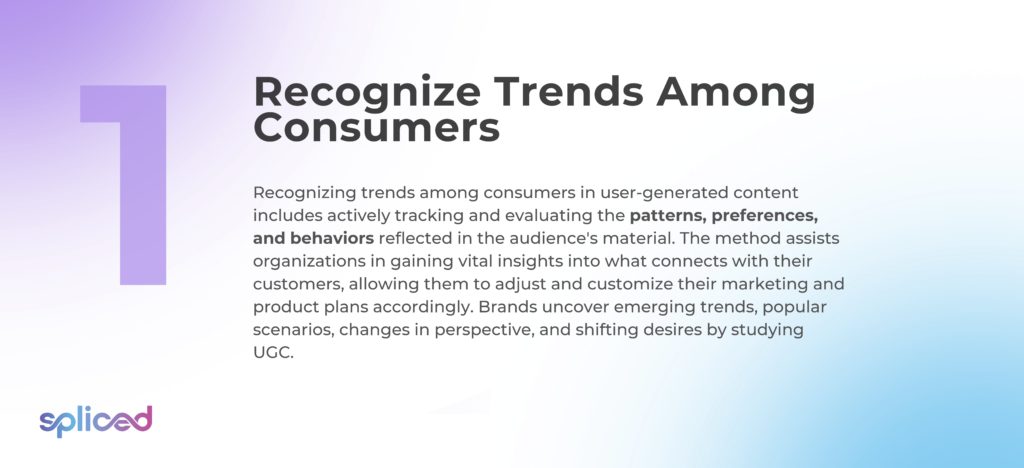
1. Recognize Trends Among Consumers
Recognizing trends among consumers in user-generated content includes actively tracking and evaluating the patterns, preferences, and behaviors reflected in the audience’s material. The method assists organizations in gaining vital insights into what connects with their customers, allowing them to adjust and customize their marketing and product plans accordingly. Brands uncover emerging trends, popular scenarios, changes in perspective, and shifting desires by studying UGC.
The data enables businesses to remain agile and responsive, ensuring they meet the changing demands and expectations of their target audience. Recognizing UGC trends not solely keeps a business competitive, but it enhances its customer-centric strategy, indicating a dedication to valuing customer feedback and providing experiences that resonate with their audience. Analyzing UGC relating to a product or service is an efficient technique to identify patterns.
For example, a cosmetics company sees that its customers are increasingly posting user-generated content that features eco-friendly packaging or cruelty-free products. The company is inspired by its trend recognition to focus on marketing its dedication to ecology and the welfare of animals, which connects with their audience and reinforces their brand identity in line with its principles.
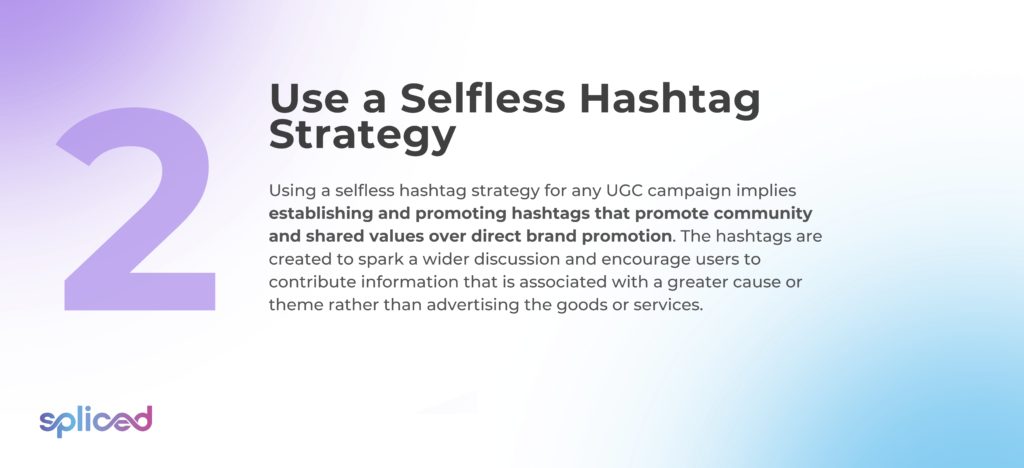
2. Use a Selfless Hashtag Strategy
Using a selfless hashtag strategy for any UGC campaign implies establishing and promoting hashtags that promote community and shared values over direct brand promotion. The hashtags are created to spark a wider discussion and encourage users to contribute information that is associated with a greater cause or theme rather than advertising the goods or services.
The technique allows brands to develop a feeling of community and inclusivity while permitting people to engage with and share what they produce in a more relevant and relatable context. It is powerful because it goes beyond self-promotion and taps into the digital age’s yearning for genuine connection and shared ideals. It cultivates a brand image based on authenticity, community, and shared purpose.
For example, a coffee business uses the hashtag #CoffeeBreak to encourage people to share their activities during breaks from work or school. The brand highlights the shared experience and moments of tranquility that coffee enthusiasts connect to, which offers a more inclusive and relatable platform for UGC contributions rather than emphasizing their coffee products.
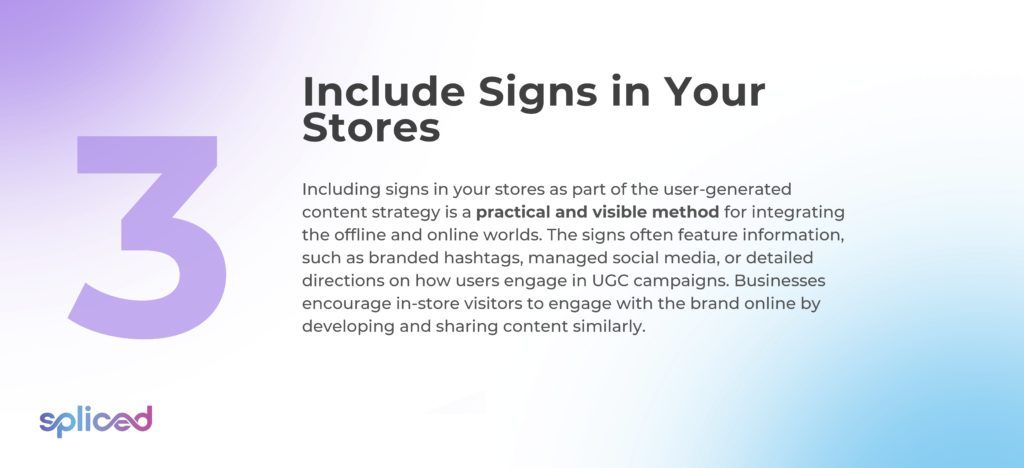
3. Include Signs in Your Stores
Including signs in your stores as part of the user-generated content strategy is a practical and visible method for integrating the offline and online worlds. The signs often feature information, such as branded hashtags, managed social media, or detailed directions on how users engage in UGC campaigns. Businesses encourage in-store visitors to engage with the brand online by developing and sharing content similarly.
The method works well because it capitalizes on the immediate customer experience and engagement in physical venues and converts it into digital content that enhances the brand’s online presence. It’s a straightforward call-to-action that greatly increases the quantity and quality of UGC, expanding the brand’s reach and interaction with the customer community.
For example, a popular restaurant posts a sign inviting customers to snap pictures of their excellent meals and share them on social media with a specific hashtag. It does not solely engage diners throughout their visit but provides free social media exposure for the business.
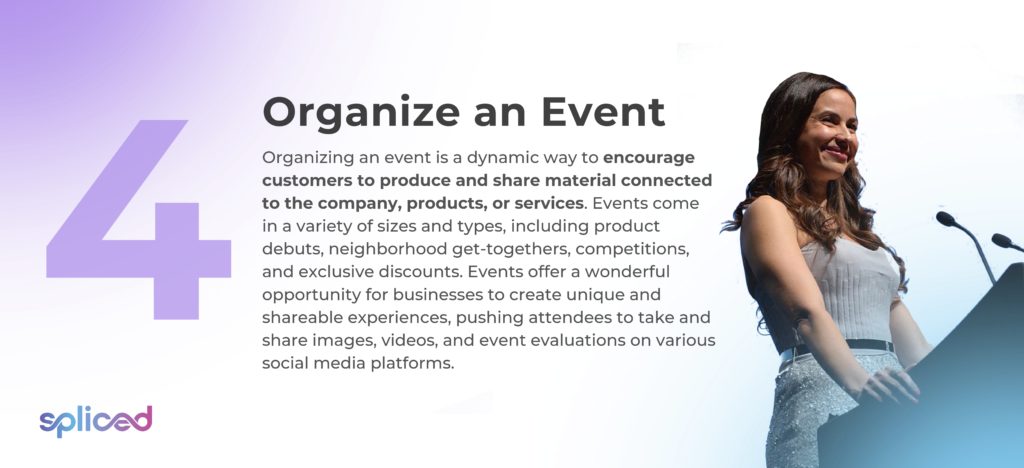
4. Organize an Event
Organizing an event is a dynamic way to encourage customers to produce and share material connected to the company, products, or services. Events come in a variety of sizes and types, including product debuts, neighborhood get-togethers, competitions, and exclusive discounts. Events offer a wonderful opportunity for businesses to create unique and shareable experiences, pushing attendees to take and share images, videos, and event evaluations on various social media platforms.
Businesses use a specified event-specific hashtag to promote the event to a wider online audience and create real-time material that favorably represents their brand. The approach is effective because it generates buzz, raises brand awareness, and builds a sense of community and loyalty among customers, making events an important component of any UGC strategy.
For example, a fashion brand hosts an event complete with a runway show and interactive interactions. Attendees are urged to snap photos, post them on social media, and use the hashtags. The resulting UGC does not just advertise the event, but exhibits the brand’s products in real-life circumstances, establishing an engaging and true relationship with its customers.
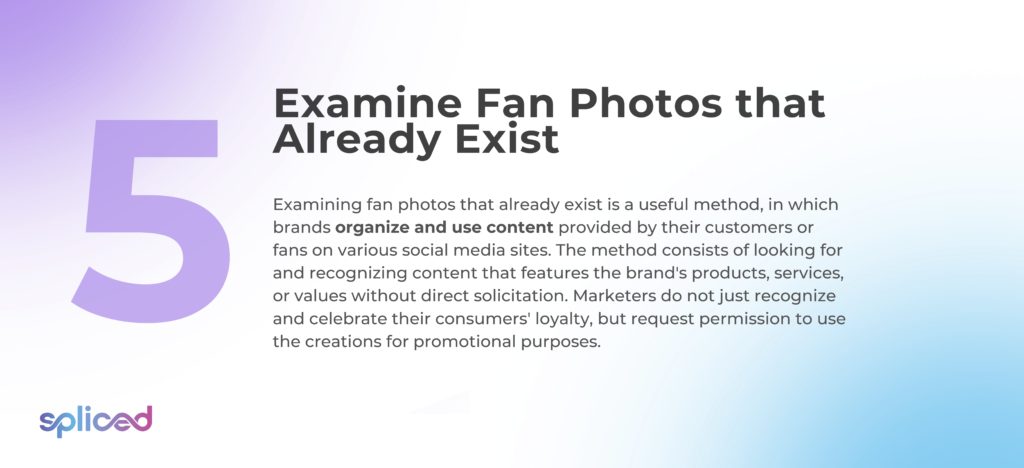
5. Examine Fan Photos that Already Exist
Examining fan photos that already exist is a useful method, in which brands organize and use content provided by their customers or fans on various social media sites. The method consists of looking for and recognizing content that features the brand’s products, services, or values without direct solicitation. Marketers do not just recognize and celebrate their consumers’ loyalty, but request permission to use the creations for promotional purposes. It is highly powerful because it promotes authenticity and allows businesses to connect with happy customers who are already enthused about their products or services. The source’s material is a valuable tool for increasing brand trust and community engagement.
For example, a reputable outdoor gear brand discovers an array of client images demonstrating their items in action by searching for hashtags. The company shows that its customers are at the center of their brand story by showcasing UGC images on their website or social media accounts along with the proper attribution. Doing it helps to celebrate the customers’ experiences and it increases the appeal of the brand.
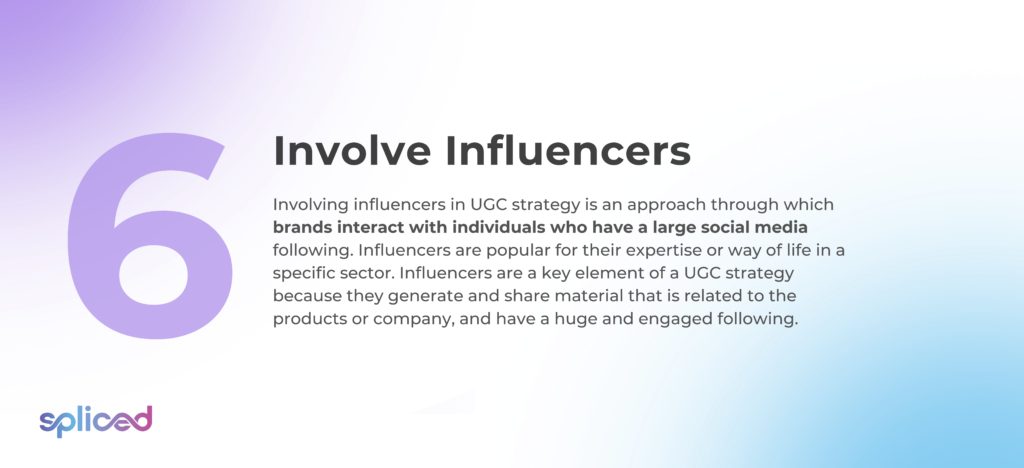
6. Involve Influencers
Involving influencers in UGC strategy is an approach through which brands interact with individuals who have a large social media following. Influencers are popular for their expertise or way of life in a specific sector. Influencers are a key element of a UGC strategy because they generate and share material that is related to the products or company, and have a huge and engaged following.
Brands leverage influencers’ credibility and reach to promote products and urge their followers to participate in UGC campaigns by partnering with them. The method is very effective as it allows the brand to reach a larger and more focused audience while leveraging the influencer’s authority to generate more UGC. It adds an aspect of authenticity when influencers share their experiences with the company, providing trustworthiness to the UGC.
For example, a fitness apparel brand collaborates with a well-known fitness Instagram influencer who frequently publishes training routines and fitness recommendations. The influencer makes UGC bring out the quality and usefulness of the brand’s items during their workouts. The followers, who believe in their fitness advice, are inspired to buy the products and share their experiences with the business, resulting in user-generated content on Instagram that is influential and relatable to the target audience.
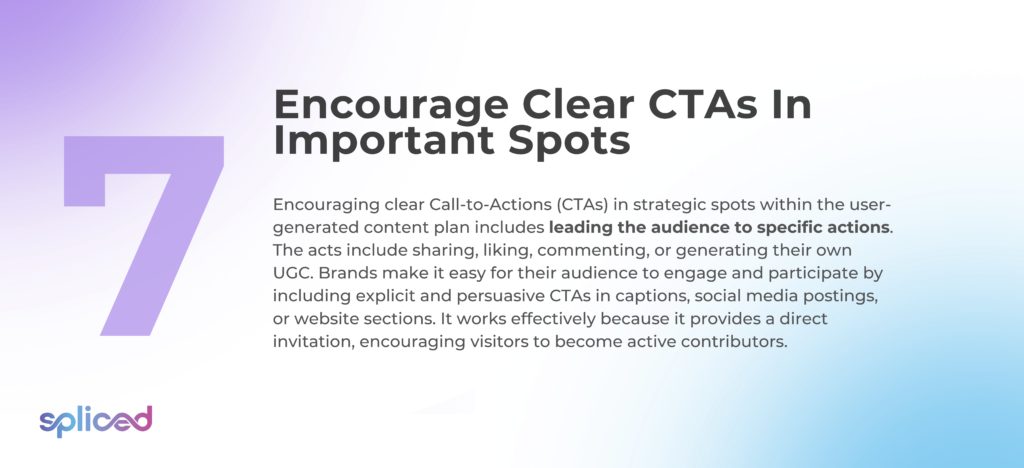
7. Encourage Clear CTAs In Important Spots
Encouraging clear Call-to-Actions (CTAs) in strategic spots within the user-generated content plan includes leading the audience to specific actions. The acts include sharing, liking, commenting, or generating their own UGC. Brands make it easy for their audience to engage and participate by including explicit and persuasive CTAs in captions, social media postings, or website sections. It works effectively because it provides a direct invitation, encouraging visitors to become active contributors. It has the ability to boost the quantity and quality of UGC, which amplifies a brand’s online presence and community engagement.
For example, a travel agency includes a clear CTA in the description of an Instagram post, asking people to contribute their finest trip images with a unique branded hashtag, such as #WanderlustAdventures. It encourages their followers to engage by sharing their own travel experiences, resulting in not just more UGC but a sense of solidarity among similar visitors.
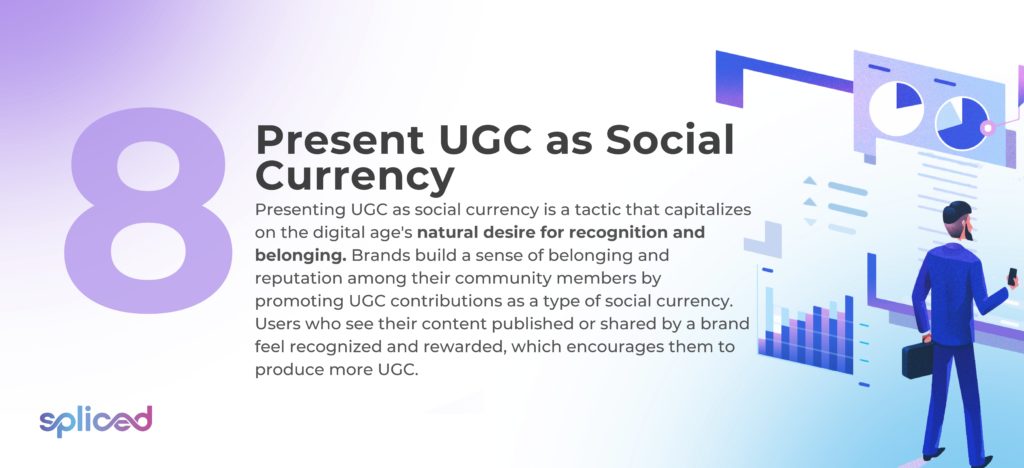
8. Present UGC as Social Currency
Presenting UGC as social currency is a tactic that capitalizes on the digital age’s natural desire for recognition and belonging. Brands build a sense of belonging and reputation among their community members by promoting UGC contributions as a type of social currency. The concept uses the human need for validation and recognition in the world of technology. Users who see their content published or shared by a brand feel recognized and rewarded, which encourages them to produce more UGC.
The method is efficient because it creates a brand community that values and celebrates its members’ contributions. It stimulates elevated user interaction, which creates a feedback loop in which more input results in more recognition, which motivates further content creation and community growth.
For example, a sports company operates a specific section on its website where it displays user-generated content of customers sporting its items while participating in physical activity. They create an environment where customers strive to be featured by uploading customer photos with captions, such as “Meet The Champions,” encouraging them to actively participate with the business, produce content, and share their fitness journey.
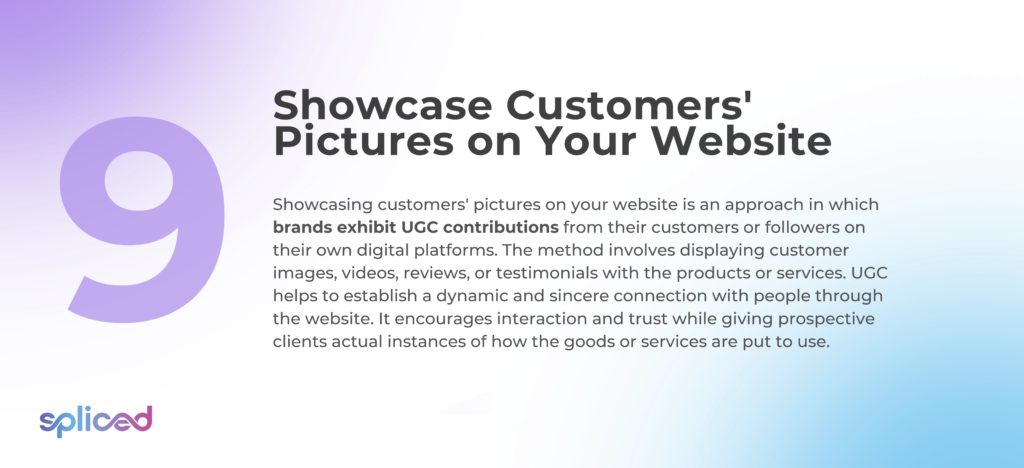
9. Showcase Customers’ Pictures on Your Website
Showcasing customers’ pictures on your website is an approach in which brands exhibit UGC contributions from their customers or followers on their own digital platforms. The method involves displaying customer images, videos, reviews, or testimonials with the products or services. UGC helps to establish a dynamic and sincere connection with people through the website. It encourages interaction and trust while giving prospective clients actual instances of how the goods or services are put to use.
The process is powerful because it enables brands to build on the genuine experiences and recommendations of satisfied customers to ensure improving their online presence and reliability. Customers are more inclined to believe user-generated content is genuine when they see it on a brand’s website.
For example, an e-commerce platform possesses a dedicated section on its website where consumers’ photographs are shown with product descriptions. Customers are encouraged to make purchases if they see pictures of other people using the products that they consider buying happily. It happens because UGC acts as social proof of the worth and appeal of the product. It adds a genuine element to the shopping experience.
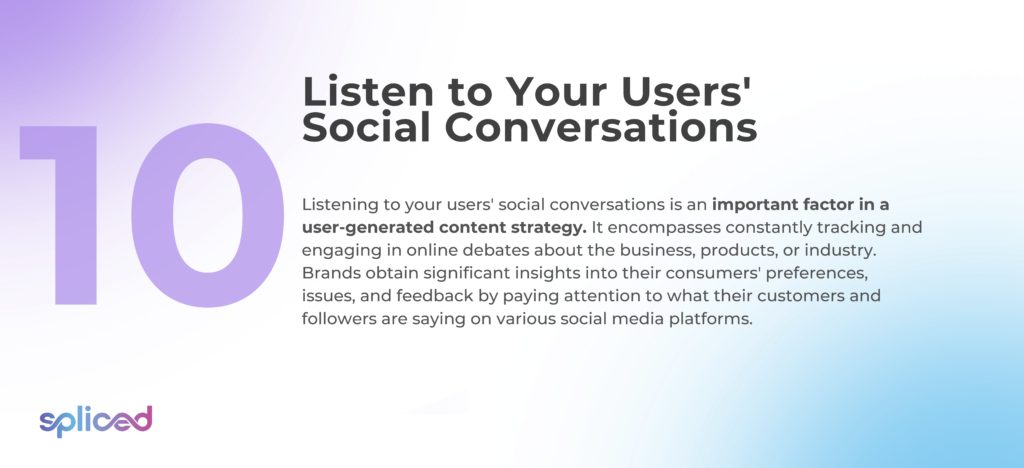
10. Listen to Your Users’ Social Conversations
Listening to your users’ social conversations is an important factor in a user-generated content strategy. It encompasses constantly tracking and engaging in online debates about the business, products, or industry. Brands obtain significant insights into their consumers’ preferences, issues, and feedback by paying attention to what their customers and followers are saying on various social media platforms.
The method helps firms interact directly with their target audience, answer queries or concerns, and develop a sense of community and trust. It is beneficial because it indicates a dedication to customer service and aids in remaining aware of the audience’s changing requirements and expectations. Brands modify their UGC strategies, content, and even product development, based on the information acquired from the dialogues.
For instance, a software corporation regularly checks social media sites for mentions of its products. The company handles it proactively by creating material or by adding functionality to their product if they see a recurrent issue or commonly asked topic. It does not just show responsiveness, but it raises consumer satisfaction and faith in the company’s dedication to its customers.
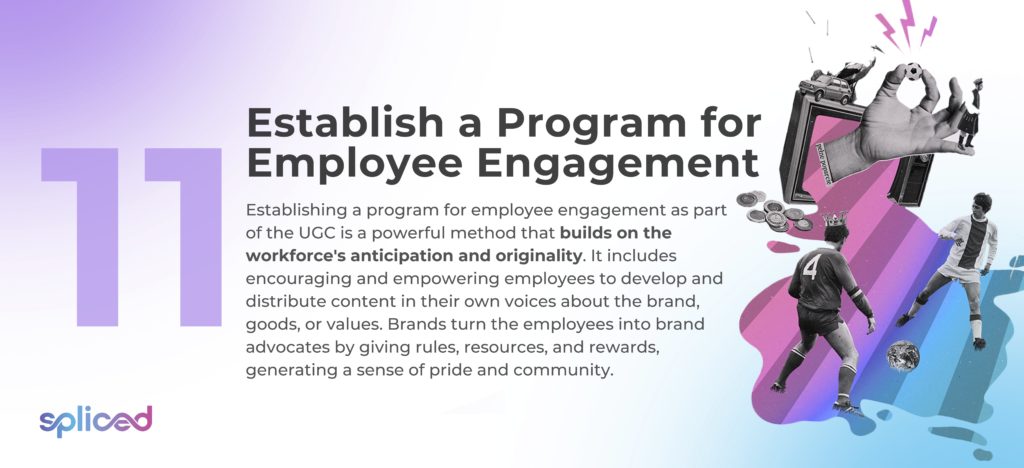
11. Establish a Program for Employee Engagement
Establishing a program for employee engagement as part of the UGC is a powerful method that builds on the workforce’s anticipation and originality. It includes encouraging and empowering employees to develop and distribute content in their own voices about the brand, goods, or values. Brands turn the employees into brand advocates by giving rules, resources, and rewards, generating a sense of pride and community.
The user-generated content tends to be influential because it relies on the internal team’s reputation and connection. Employees are often seen as reliable sources, and their information connects with the audience on a personal level. It boosts employees’ morale and gives authenticity to the company’s online presence.
For example, an application development corporation encourages its developers to provide code insights, while a fashion retailer allows staff to showcase their style using the brand’s items. The material is distributed via social media or the company’s website, resulting in a real and interactive relationship with the audience. Employees who actively participate in the engagement program receive incentives, recognition, or awards, further pushing them to contribute.
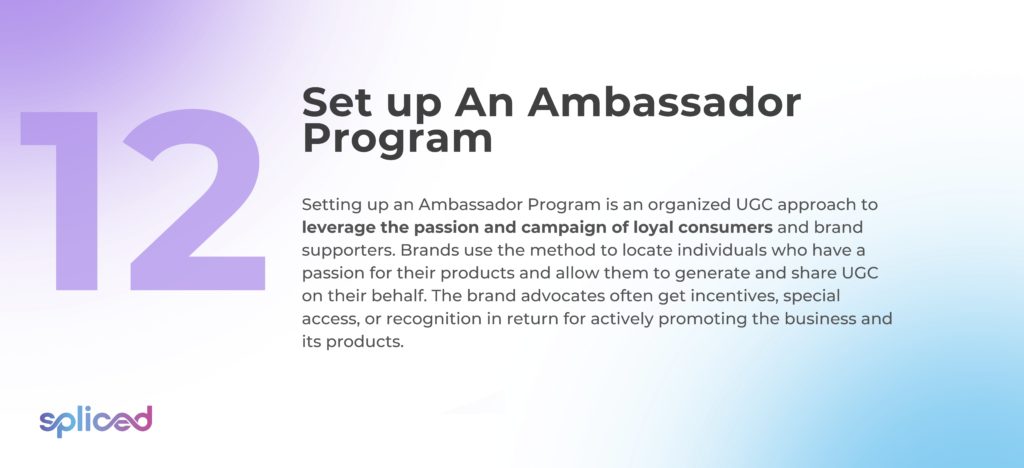
12. Set up An Ambassador Program
Setting up an Ambassador Program is an organized UGC approach to leverage the passion and campaign of loyal consumers and brand supporters. Brands use the method to locate individuals who have a passion for their products and allow them to generate and share UGC on their behalf. The brand advocates often get incentives, special access, or recognition in return for actively promoting the business and its products.
The method is effective because it takes advantage of the advocate’s reliability and reach, simply transforming them into content creators and influencers for the business. It boosts involvement in the community and brand authenticity while growing the UGC, and fostering long-lasting relationships with the most loyal clients.
For example, a cosmetics company identifies a group of customers who consistently publish makeup tutorials and reviews using their products. The customers are invited to be the brand ambassadors, given unique product previews, and encouraged to generate UGC highlighting the products. The ambassadors make original content that engages with their own followers, helping the brand gain solid credibility among the community.
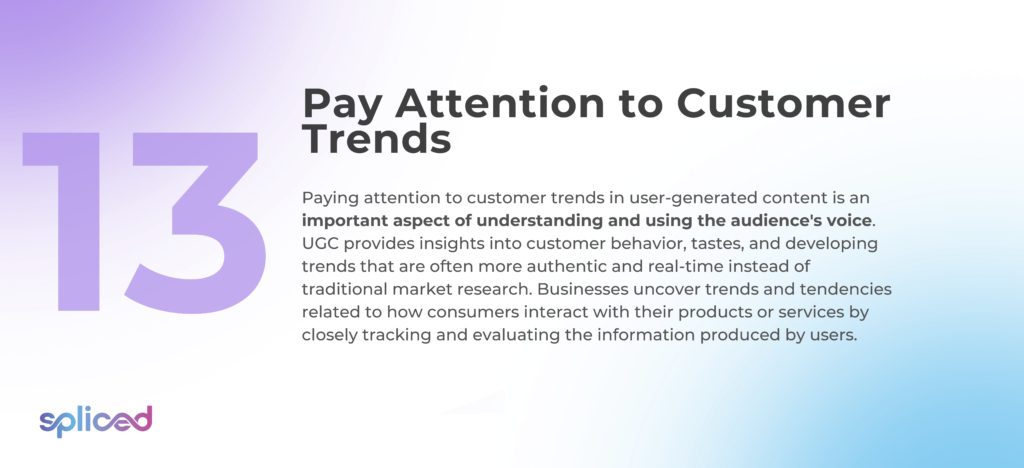
13. Pay Attention to Customer Trends
Paying attention to customer trends in user-generated content is an important aspect of understanding and using the audience’s voice. UGC provides insights into customer behavior, tastes, and developing trends that are often more authentic and real-time instead of traditional market research. Businesses uncover trends and tendencies related to how consumers interact with their products or services by closely tracking and evaluating the information produced by users. It involves identifying common use cases, unmet needs, new product trends, or even changes in attitude.
The data helps organizations remain flexible and responsive in a fast-paced digital marketplace by informing marketing strategies, product development, and consumer interaction initiatives. Recognizing consumer trends in UGC does not just assist businesses in meeting customer expectations, but empowers them to establish a closer relationship with their audience by displaying how they are attentive to their feedback and preferences.
For example, a meal delivery business learns that UGC often features consumers discussing their innovative at-home dining experiences. The business responded by creating a campaign, encouraging users to share their special home-cooked meals with a branded hashtag, capitalizing on the trend, and enhancing customer engagement.
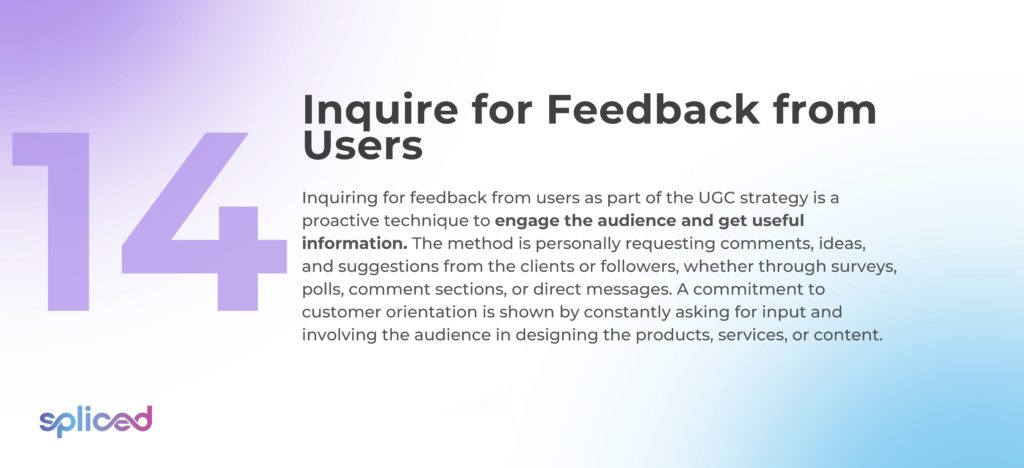
14. Inquire for Feedback from Users
Inquiring for feedback from users as part of the UGC strategy is a proactive technique to engage the audience and get useful information. The method is personally requesting comments, ideas, and suggestions from the clients or followers, whether through surveys, polls, comment sections, or direct messages. A commitment to customer orientation is shown by constantly asking for input and involving the audience in designing the products, services, or content.
Helping people feel important and it supplies useful data that helps companies make corporate choices and create content. Users’ feedback is frequently a source of ideas and inspiration for UGC campaigns and content strategies, helping businesses to develop material that relates to and satisfies the expectations of their target audience. Inquiring for feedback does not just increase engagement but allows consumers to actively participate in the growth and evolution of the business.
For example, an e-learning platform conducts a social media poll asking users what topics they prefer to see covered in their next course. The close connection does not just collect useful feedback, but provides content inspiration for future courses, ensuring that the platform fulfills the specific requirements and interests of its audience.
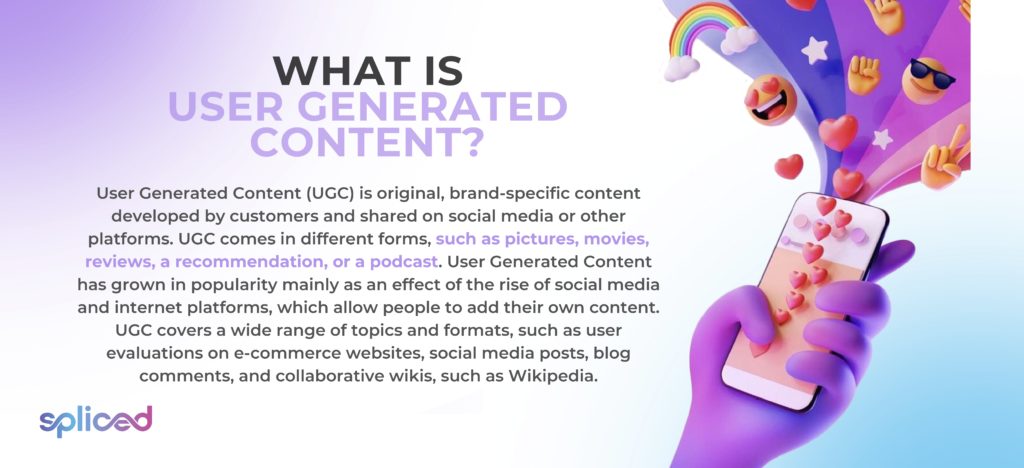
What is User Generated Content?
User Generated Content (UGC) is original, brand-specific content developed by customers and shared on social media or other platforms. UGC comes in different forms, such as pictures, movies, reviews, a recommendation, or a podcast. User Generated Content has grown in popularity mainly as an effect of the rise of social media and internet platforms, which allow people to add their own content. UGC covers a wide range of topics and formats, such as user evaluations on e-commerce websites, social media posts, blog comments, and collaborative wikis, such as Wikipedia.
UGC’s appeal comes from its authenticity and diversity because it often conveys the true ideas, experiences, and viewpoints of ordinary people. Companies and organizations regularly use UGC content to engage with customers, acquire insights, and improve their online presence. It is a strong tool for promoting trust and community involvement by getting content. The User Generated Content presents difficulties, such as the necessity to control and moderate content to maintain quality and assure compliance with legal and ethical norms.
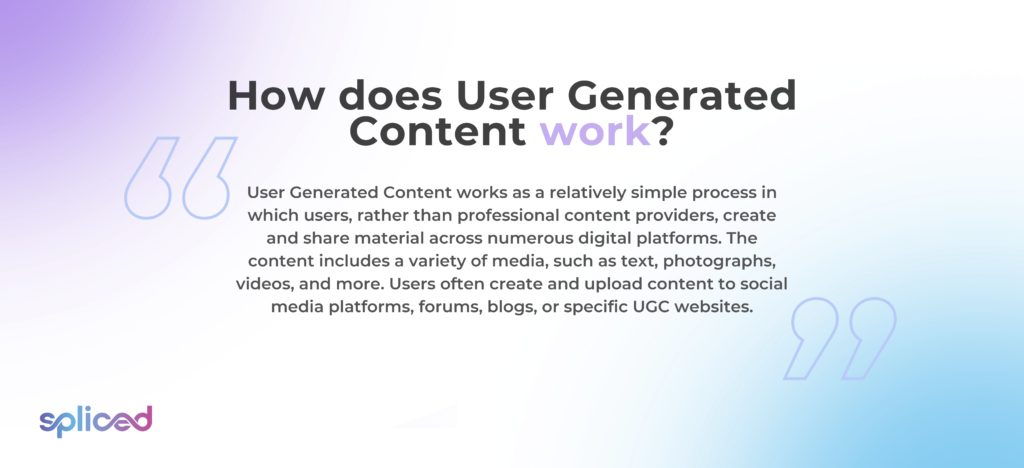
How does User Generated Content work?
User Generated Content works as a relatively simple process in which users, rather than professional content providers, create and share material across numerous digital platforms. The content includes a variety of media, such as text, photographs, videos, and more. Users often create and upload content to social media platforms, forums, blogs, or specific UGC websites. They offer personal experiences, reviews, opinions, or creative works, and the content is frequently motivated by the user’s own interests, experiences, or wants to engage with a particular group or audience. It gains visibility as others interact with it through likes, shares, comments, and other user-generated contributions when UGC is shared.
Brands and organizations frequently promote UGC by launching campaigns or holding contests in which users are invited to submit content relating to their products or services. The material is used for marketing and engagement purposes. Some of UGC’s primary characteristics include its authenticity and relatability, as it allows a varied range of voices and viewpoints to be heard in the digital realm. Moderation and curation are required to verify the user’s ideas or information adhere to the platform’s guidelines and legal standards.
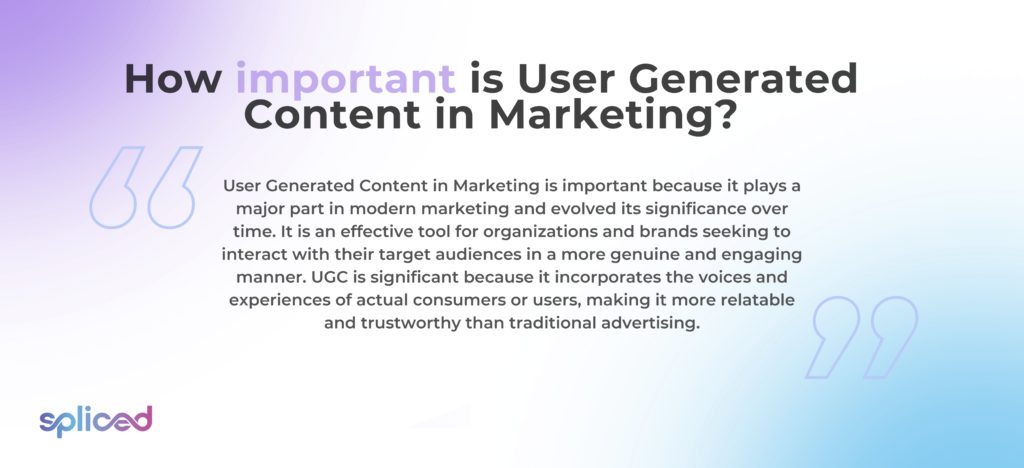
How important is User Generated Content in Marketing?
User Generated Content in Marketing is important because it plays a major part in modern marketing and evolved its significance over time. It is an effective tool for organizations and brands seeking to interact with their target audiences in a more genuine and engaging manner. UGC is significant because it incorporates the voices and experiences of actual consumers or users, making it more relatable and trustworthy than traditional advertising. Potential customers’ purchasing decisions are influenced by it because it promotes a sense of community and participation and serves as social evidence.
UGC has a chance to increase brand exposure, credibility, and customer loyalty greatly. It relieves businesses of the pressure of constantly creating original content by allowing them to tap into a rich resource of user-generated content. UGC gets an appealing and affordable way to improve its online presence and spur business growth when it is properly tapped into and integrated into its marketing strategy. Businesses must strike a balance by supporting user-generated content while simultaneously monitoring and controlling it to maintain quality and assure compliance with ethical and regulatory requirements.

Is UGC the same as Influencer Marketing?
No, UGC is not the same as Influencer Marketing. Influencer Marketing and User Generated Content (UGC) are related but are unique when it comes to digital marketing tactics. UGC is defined as content made spontaneously, voluntarily by customers or users of a company, and sometimes unpaid and motivated by their own experiences and opinions. It is genuine and unsolicited materials that portray the brand from the perspective of its customers. Influencer marketing involves working with individuals known as influencers who have a large following on social media or other platforms. Influencers are usually paid to promote a brand’s products or services, and their endorsements are more formal and professional.
The main differences between UGC and influencer marketing are found in their roots and features. The user-generated content is naturally created by regular consumers and represents their real experiences, while influencer marketing makes use of the popularity and authority of well-known personalities within particular niches. The two strategies have distinct advantages and must be used effectively depending on the goals and target audience of a company, with UGC focusing on originality and influencer marketing implementing credibility.
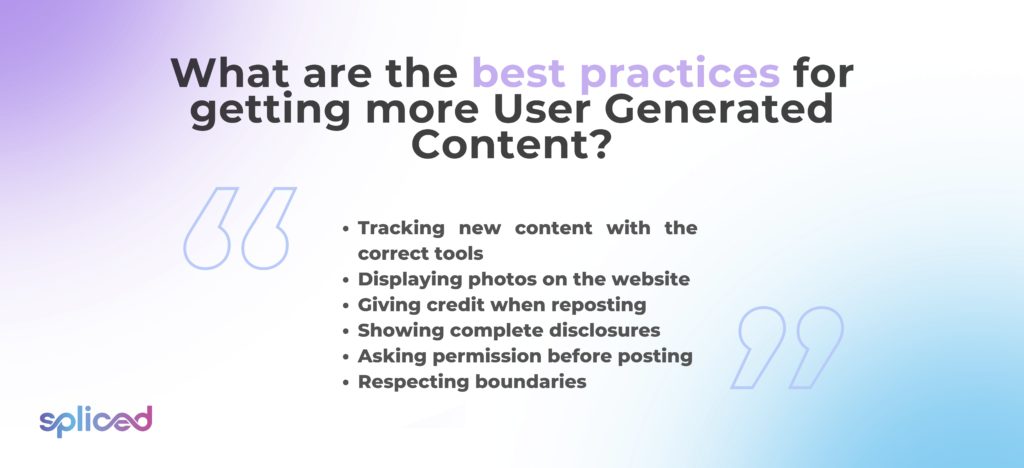
What are the best practices for getting more User Generated Content?
The best practices for getting more User Generated Content are listed below.
- Tracking new content with the correct tools: Monitor and regulate UGC regularly to ensure it is consistent with the business’s image and adheres to guidelines and legal norms.
- Display photos on the website: Display user-generated content (UGC) on the website, particularly on product pages, where it affects potential clients and builds credibility.
- Give credit when reposting: Properly credit the original owner because it helps keep the online presence of the business transparent and honest while demonstrating appreciation for the person who submitted the information.
- Showing complete disclosures: Disclosures that are complete and honest not simply safeguard the brand from potential legal difficulties, but develop trust with the audience. The techniques help improve the brand’s reputation and integrity in an age when authenticity and transparency are highly valued.
- Ask permission before posting: Obtaining permission before using UGC shows respect for the creator’s intellectual property but contributes to the development of beneficial connections with the audience and content producers. It promotes transparency and ethical behavior in the digital environment.
- Boundaries must be respected: Boundaries must be respected in UGC for legal reasons and ethical reasons. It enables businesses to maintain trust with their audience and content creators while maintaining a positive and courteous online presence for their brand.

How much does User Generated Content cost?
User Generated Content costs an average of $320 in 2023. The amount UGC creators earn is determined by some factors, including their level of experience, the type of content they publish, the platform they utilize, and the size of their following. The price of User Generated Content (UGC) varies based on several factors. UGC is often provided voluntarily by individuals who do not get direct compensation, making it a cost-effective alternative for marketers to obtain content. Some instances in which enterprises face UGC-related costs. It involves running UGC campaigns, contests, or influencer collaborations in which businesses offer rewards or prizes for a fee.
Businesses spend in monitoring and editing to ensure that UGC is consistent with their brand image and legal guidelines. The entire cost of UGC varies on the volume and type of the UGC efforts, and whether contributors are compensated. It is regarded as a more economical and authentic marketing technique when compared to producing every material in-house.
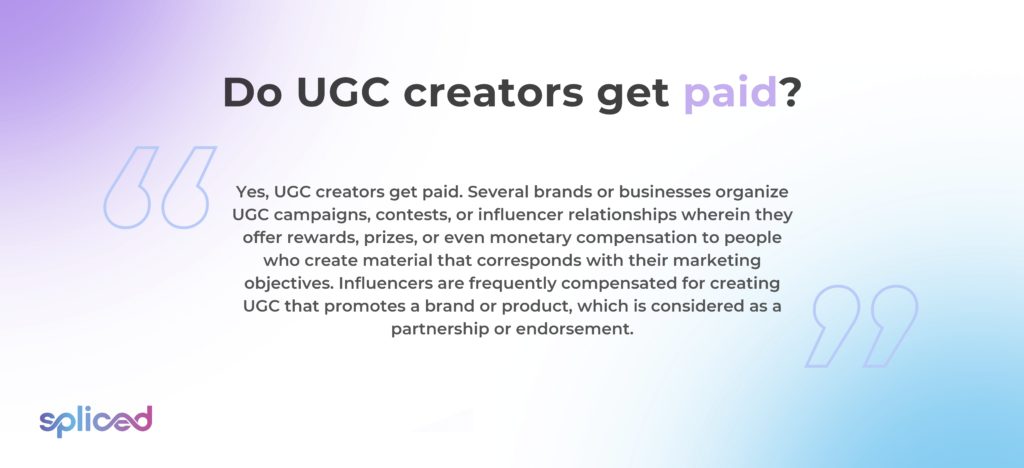
Do UGC creators get paid?
Yes, UGC creators get paid. Several brands or businesses organize UGC campaigns, contests, or influencer relationships wherein they offer rewards, prizes, or even monetary compensation to people who create material that corresponds with their marketing objectives. Influencers are frequently compensated for creating UGC that promotes a brand or product, which is considered as a partnership or endorsement.
Individuals offer content to UGC without receiving direct financial rewards. They are doing it because of their genuine care about a company, product, or community, or merely to share their experiences and ideas with a larger audience. Many contribute out of personal curiosity and enthusiasm while UGC creators are compensated in specific cases, seeing UGC as a means to express themselves and connect with others rather than a source of income.
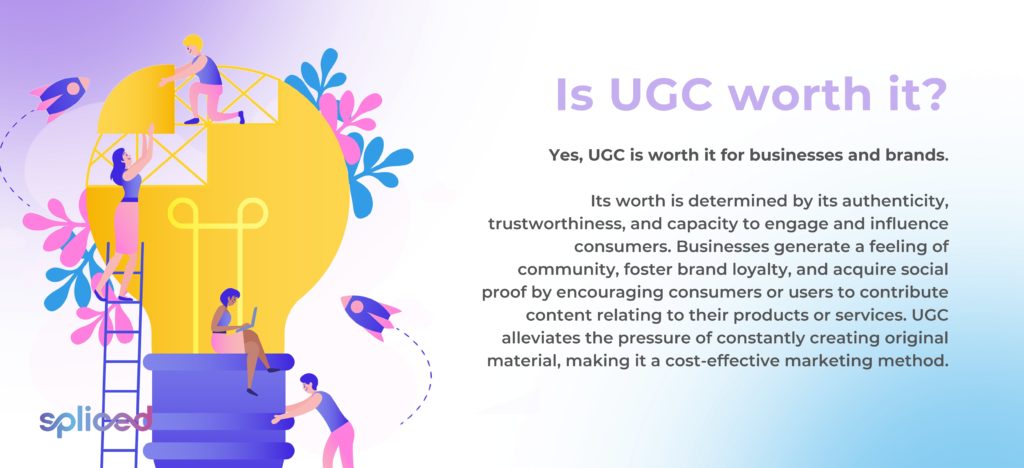
Is UGC worth it?
Yes, UGC is worth it for businesses and brands. Its worth is determined by its authenticity, trustworthiness, and capacity to engage and influence consumers. Businesses generate a feeling of community, foster brand loyalty, and acquire social proof by encouraging consumers or users to contribute content relating to their products or services. UGC alleviates the pressure of constantly creating original material, making it a cost-effective marketing method.
The effectiveness of UGC is influenced by a few factors, including the significance and standard of the content, the platform used, and targeted audiences. Businesses must invest in content moderation to ensure that it matches their brand values and ethical standards. User-generated content (UGC) is an effective tool for advertising, but its success is dependent on strategic planning and management, making it valuable for many firms.
